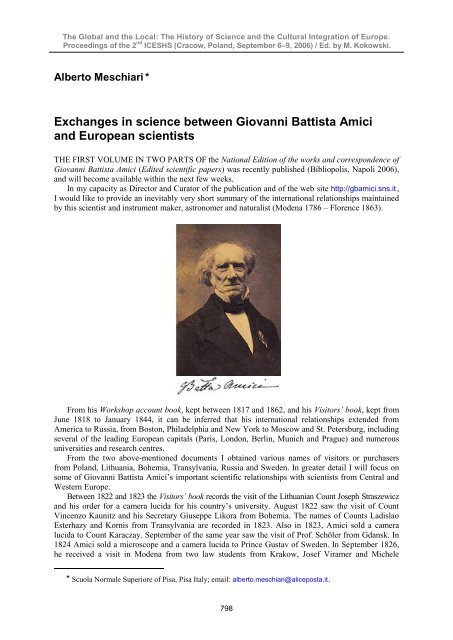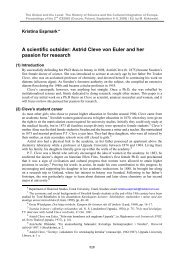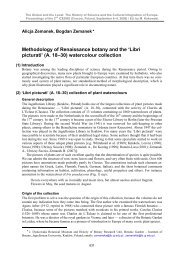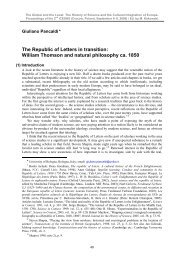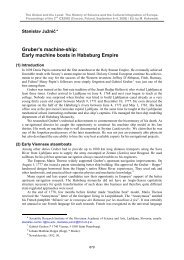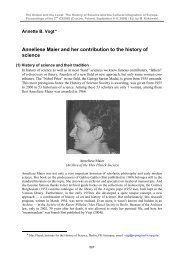Exchanges in science between Giovanni Battista Amici - 2nd ICESHS
Exchanges in science between Giovanni Battista Amici - 2nd ICESHS
Exchanges in science between Giovanni Battista Amici - 2nd ICESHS
Create successful ePaper yourself
Turn your PDF publications into a flip-book with our unique Google optimized e-Paper software.
The Global and the Local: The History of Science and the Cultural Integration of Europe.<br />
Proceed<strong>in</strong>gs of the 2 nd <strong>ICESHS</strong> (Cracow, Poland, September 6–9, 2006) / Ed. by M. Kokowski.<br />
Alberto Meschiari *<br />
<strong>Exchanges</strong> <strong>in</strong> <strong>science</strong> <strong>between</strong> <strong>Giovanni</strong> <strong>Battista</strong> <strong>Amici</strong><br />
and European scientists<br />
THE FIRST VOLUME IN TWO PARTS OF the National Edition of the works and correspondence of<br />
<strong>Giovanni</strong> <strong>Battista</strong> <strong>Amici</strong> (Edited scientific papers) was recently published (Bibliopolis, Napoli 2006),<br />
and will become available with<strong>in</strong> the next few weeks.<br />
In my capacity as Director and Curator of the publication and of the web site http://gbamici.sns.it ,<br />
I would like to provide an <strong>in</strong>evitably very short summary of the <strong>in</strong>ternational relationships ma<strong>in</strong>ta<strong>in</strong>ed<br />
by this scientist and <strong>in</strong>strument maker, astronomer and naturalist (Modena 1786 – Florence 1863).<br />
From his Workshop account book, kept <strong>between</strong> 1817 and 1862, and his Visitors’ book, kept from<br />
June 1818 to January 1844, it can be <strong>in</strong>ferred that his <strong>in</strong>ternational relationships extended from<br />
America to Russia, from Boston, Philadelphia and New York to Moscow and St. Petersburg, <strong>in</strong>clud<strong>in</strong>g<br />
several of the lead<strong>in</strong>g European capitals (Paris, London, Berl<strong>in</strong>, Munich and Prague) and numerous<br />
universities and research centres.<br />
From the two above-mentioned documents I obta<strong>in</strong>ed various names of visitors or purchasers<br />
from Poland, Lithuania, Bohemia, Transylvania, Russia and Sweden. In greater detail I will focus on<br />
some of <strong>Giovanni</strong> <strong>Battista</strong> <strong>Amici</strong>’s important scientific relationships with scientists from Central and<br />
Western Europe.<br />
Between 1822 and 1823 the Visitors’ book records the visit of the Lithuanian Count Joseph Straszewicz<br />
and his order for a camera lucida for his country’s university. August 1822 saw the visit of Count<br />
V<strong>in</strong>cenzo Kaunitz and his Secretary Giuseppe Likora from Bohemia. The names of Counts Ladislao<br />
Esterhazy and Kornis from Transylvania are recorded <strong>in</strong> 1823. Also <strong>in</strong> 1823, <strong>Amici</strong> sold a camera<br />
lucida to Count Karaczay. September of the same year saw the visit of Prof. Schöler from Gdansk. In<br />
1824 <strong>Amici</strong> sold a microscope and a camera lucida to Pr<strong>in</strong>ce Gustav of Sweden. In September 1826,<br />
he received a visit <strong>in</strong> Modena from two law students from Krakow, Josef Viramer and Michele<br />
* Scuola Normale Superiore of Pisa, Pisa Italy; email: alberto.meschiari@aliceposta.it .<br />
798
CHAPTER 26. / Symposium R-18.<br />
Circulat<strong>in</strong>g knowledge: A European perspective on communication of <strong>science</strong><br />
Rostasiricke. In 1833 the Polish count Zamoyschi purchased a pocket microscope from <strong>Amici</strong> <strong>in</strong><br />
Florence. Aga<strong>in</strong> <strong>in</strong> 1833 he received a visit from Messers Czachi, from Poland. In 1835 or 1836, Dr.<br />
Sauvan from Poland purchased a good quality pocket microscope from his workshop. In May 1837 he<br />
received a visit from Major General Tcheffk<strong>in</strong>e, head of the m<strong>in</strong>e eng<strong>in</strong>eers of Russia <strong>in</strong> St. Petersburg,<br />
who placed an order for a vertical microscope and a reflect<strong>in</strong>g circle. The name of Alexandr Nikolaevič<br />
Draschusov, astronomer and professor of Astronomy at the University of Moscow, is registered <strong>in</strong> May<br />
1838. In 1848 he sold a microscope and a meridian to Prof. Wallmark of Stockholm, director of the<br />
local Technical Institute. The microscope is still conserved. In 1857 he sold a large microscope to<br />
professor Josef Hasner of Prague. The same year he sold a small microscope to Dr. August Breisky,<br />
dissector at the Prague Anatomical Institute. In December 1861, Moscow Botany Professor, Serge<br />
Raczynski, made a purchase of a small microscope and a pocket microscope. In April 1862, Doctor<br />
Georg Holdt from Russia purchased a large model microscope with a 160º degree aperture objective,<br />
immersed <strong>in</strong> aniseed and sassafras oil, which is still conserved at the Fondazione Scienza e Tecnica <strong>in</strong><br />
Florence.<br />
In 1817, through the mediation of Capta<strong>in</strong> Wilhelm von Biela, a German astronomer of Bohemian<br />
descent known for his discovery <strong>in</strong> 1826 of the comet subsequently named after him, Prof. Cassiano<br />
Hallaschka had <strong>Amici</strong>’s catadioptric microscope delivered to Prague, which he used <strong>in</strong> the Physics<br />
Museum.<br />
Remember<strong>in</strong>g that <strong>in</strong>strument, <strong>in</strong> 1858 Jan Evangelista Purkyne ordered from <strong>Amici</strong> the small<br />
achromatic microscope which at the Paris Exposition of 1855 surpassed all rivals <strong>in</strong> the cont<strong>in</strong>ent hors<br />
concours by virtue of its water immersion objective. But it was from the second half of the 1850s<br />
onwards that <strong>Amici</strong>’s microscopes achieved widespread success <strong>in</strong> Prague. The <strong>in</strong>termediaries were<br />
the Batka brothers, and especially the Bohemian doctor Wilhelm Dusan Lambl, Purkyne’s assistant,<br />
who dur<strong>in</strong>g a journey through Italy <strong>in</strong> 1856 had the opportunity to admire <strong>Amici</strong>’s lenses <strong>in</strong> Florence.<br />
Naturally he ma<strong>in</strong>ta<strong>in</strong>ed more regular and substantial relations with Englishmen, Frenchmen and<br />
Germans.<br />
From the start of his activities <strong>Giovanni</strong> <strong>Battista</strong> <strong>Amici</strong> measured himself aga<strong>in</strong>st theoretical and<br />
practical problems that were debated <strong>in</strong> the scientific circles of the European capitals, especially Paris<br />
and London, aga<strong>in</strong>st the solutions proposed by the likes of Herschel, Dollond, Ramsden, Bessel, Short,<br />
Wollaston, Boscovich, Rochon, Maskelyne, Bouguer, Smith, Barker, etc. The same applies to the<br />
botanical observations of Brongniart, Mirbel, Brown, Schleiden, etc. Renowned throughout Europe,<br />
<strong>Amici</strong> ma<strong>in</strong>ta<strong>in</strong>ed relations with some of the great scientists of the times, such as Brewster, von Zach,<br />
John Herschel, Airy and Talbot.<br />
In the autumn of 1815 a Wollaston type camera lucida built by Dumotiez was purchased <strong>in</strong> Paris<br />
for use by the Physics Institute of the University of Modena. After exam<strong>in</strong><strong>in</strong>g the <strong>in</strong>strument and<br />
discuss<strong>in</strong>g its advantages and defects with Archdukes Maximilian and Ferd<strong>in</strong>and of Austria-Este,<br />
<strong>Amici</strong> thought he could improve it by adopt<strong>in</strong>g a new construction. His version enjoyed great success<br />
and he received orders from every part of Italy. Incidentally, J. F. W. Herschel preferred it to<br />
Wollaston’s model by virtue of its ease of use.<br />
In September 1820, Baron Franz Xaver von Zach visited <strong>Amici</strong>’s workshop <strong>in</strong> Modena, where he<br />
was particularly impressed by the prism reflect<strong>in</strong>g sector that <strong>Amici</strong> was mak<strong>in</strong>g. Encouraged by his<br />
appreciation, <strong>Amici</strong> f<strong>in</strong>ished the <strong>in</strong>strument and <strong>in</strong> the summer of 1822 took it with him to Genoa,<br />
where the Baron was liv<strong>in</strong>g at that time. There, together with Swiss astronomer Johann Kaspar Horner,<br />
they tested it by carry<strong>in</strong>g out several observations. Zach was so enthusiastic that he helped <strong>Amici</strong> look<br />
for the optical glass for further prisms from Utzschneider and Fraunhofer <strong>in</strong> Munich. Between 1822<br />
and 1825 he also published <strong>in</strong> his ―Correspondance astronomique‖ a total of seven scientific letters<br />
from <strong>Amici</strong>.<br />
In April 1824, John Frederik William Herschel passed through Modena while travell<strong>in</strong>g <strong>in</strong> Italy.<br />
He and <strong>Amici</strong> used <strong>Amici</strong>’s reflect<strong>in</strong>g telescopes to perform observations of double stars, try<strong>in</strong>g out<br />
the new double-image micrometer. On his return to London after the summer, Herschel took one of<br />
the micrometers with him and presented it at the first meet<strong>in</strong>g of the Astronomical Society. In the<br />
meantime, Joseph Fraunhofer had <strong>in</strong>formed the scientific world of the construction of his large<br />
refractor for Dorpat. And s<strong>in</strong>ce the excellence of the <strong>in</strong>strument was such that some people believed it<br />
to have superseded reflect<strong>in</strong>g telescopes once and for all, on 15 August 1825 Herschel took sides <strong>in</strong><br />
799
Alberto Meschiari<br />
<strong>Exchanges</strong> <strong>in</strong> <strong>science</strong> <strong>between</strong> <strong>Giovanni</strong> <strong>Battista</strong> <strong>Amici</strong> and European scientists<br />
the debate with a letter from Slough to the ―Astronomische Nachrichten‖, <strong>in</strong> which he declared that,<br />
―Those who have witnessed the performance of M. <strong>Amici</strong>’s beautiful Newtonian reflectors, will not<br />
readily admit this <strong>in</strong>feriority.‖ For several years the two scientists exchanged books, articles and<br />
observations on double and triple stars.<br />
Also <strong>in</strong> 1824 <strong>Amici</strong> resumed his experiments on lenses after read<strong>in</strong>g Fresnel’s report to the Royal<br />
Academy of Sciences of Paris on the Selligue achromatic microscope.<br />
When three years later he made his first journey to Paris and London, along with other <strong>in</strong>struments<br />
he took with him his new achromatic microscope, which prompted great <strong>in</strong>terest amongst <strong>in</strong>strument<br />
makers and naturalists <strong>in</strong> the two capitals. In Paris it was acknowledged that many observations would<br />
have to be repeated and corrected as a result of the great difference <strong>between</strong> the <strong>in</strong>struments that had<br />
previously been used and the microscope that <strong>Amici</strong> had brought with him. V<strong>in</strong>cent Chevalier, who<br />
was already mak<strong>in</strong>g and sell<strong>in</strong>g <strong>Amici</strong>’s camera lucida, wanted to do the same with his achromatic and<br />
catadioptric microscopes, and for this reason asked <strong>Amici</strong> to supply him with the famous elliptical<br />
mirror that no one could match.<br />
In London, <strong>in</strong> the company of Joseph Jackson Lister, <strong>Amici</strong>’s objectives were compared with the<br />
achromatic objectives produced by Gor<strong>in</strong>g, Tulley and Dollond, with those made by Lister and by Dr.<br />
Hodk<strong>in</strong>, and with John Cuthbert’s <strong>Amici</strong>an microscope.<br />
When pass<strong>in</strong>g through Paris for the second time on his return from London, <strong>Amici</strong> agreed to sell<br />
his achromatic microscope to Adolphe Brongniart, who was very impressed with it and used it for his<br />
observations on fertilisation <strong>in</strong>stead of the Selligue that he had used up until then. Mirbel received<br />
another further improved model the follow<strong>in</strong>g year. If we also consider the <strong>in</strong>strument used by <strong>Amici</strong><br />
and the one purchased <strong>in</strong> 1845 by Hugo Mohl for his research on plant cell development, it will be<br />
clear that <strong>Amici</strong>’s microscope played a lead<strong>in</strong>g role <strong>in</strong> this type of <strong>in</strong>vestigation and allowed the<br />
process to be expla<strong>in</strong>ed correctly.<br />
In September 1829, George Biddel Airy also visited <strong>Amici</strong> <strong>in</strong> Modena. In 1838, us<strong>in</strong>g the highdispersion<br />
Faraday glass that Airy had obta<strong>in</strong>ed for him, <strong>Amici</strong> made the hemispherical front lens for<br />
the achromatic microscope for Rev. Thomas Romney Rob<strong>in</strong>son, director of the Armagh Observatory<br />
<strong>in</strong> Ireland. The same year, Rob<strong>in</strong>son purchased from the Florence workshop — <strong>Amici</strong> had moved to<br />
Florence <strong>in</strong> 1831 — a prism reflect<strong>in</strong>g circle, which he assigned to James Clark Ross’s Antarctic<br />
Expedition.<br />
The photography pioneer William Henry Fox Talbot and <strong>Giovanni</strong> <strong>Battista</strong> <strong>Amici</strong> first met <strong>in</strong><br />
Modena <strong>in</strong> September 1822, when the English scientist, who had read <strong>Amici</strong>’s paper on catadioptric<br />
microscopes, wanted to purchase one of these <strong>in</strong>struments. The two met aga<strong>in</strong> <strong>in</strong> Modena <strong>in</strong> March<br />
1826, then <strong>in</strong> London <strong>in</strong> 1827. Twelve years later, <strong>in</strong> 1839, <strong>Amici</strong> <strong>in</strong>vited Talbot to take part <strong>in</strong> the<br />
First Meet<strong>in</strong>g of Italian scientists <strong>in</strong> Pisa, of which he was one of the six promoters. Talbot, who <strong>in</strong> the<br />
meantime had heard of the success achieved by Daguerre <strong>in</strong> fix<strong>in</strong>g images by means of light, decided<br />
to take advantage of the event, which would be attended by scientists from all over Europe, to<br />
publicise his photogenic draw<strong>in</strong>gs. For this purpose, he resumed correspondence with <strong>Amici</strong>, to whom<br />
he sent some of his recent works. But it was only after various vicissitudes that <strong>in</strong> early 1842 <strong>Amici</strong><br />
received what had become Talbot’s calotypes, and presented them <strong>in</strong> February to a meet<strong>in</strong>g of the<br />
Accademia dei Georgofili <strong>in</strong> Florence.<br />
In his <strong>in</strong>vestigations <strong>in</strong>to the fertilisation of phanerogamous plants, <strong>Amici</strong> could hardly have failed<br />
to have met up with Robert Brown, whose acqua<strong>in</strong>tance he had first made <strong>in</strong> London <strong>in</strong> 1827. In 1841,<br />
Brown took part <strong>in</strong> the Third Meet<strong>in</strong>g of Italian scientists <strong>in</strong> Florence and on 17 September, visit<strong>in</strong>g<br />
<strong>Amici</strong>’s workshop, he purchased a vertical microscope with n<strong>in</strong>e objectives. Brown made an<br />
important contribution to the success of <strong>Amici</strong>’s observations on the fertilisation process when he<br />
suggested that he should concentrate on Orchids. Hugo Mohl and Wilhelm Hofmeister subsequently<br />
confirmed <strong>Amici</strong>’s conclusions contradict<strong>in</strong>g the theories of Schleiden.<br />
When <strong>in</strong> the early 1850s the v<strong>in</strong>eyards of half of Europe were <strong>in</strong>fested by cryptogam, <strong>Amici</strong>, who<br />
had been appo<strong>in</strong>ted by the Accademia dei Georgofili to make microscope observations of the fungus,<br />
engaged <strong>in</strong> an <strong>in</strong>tense correspondence on the subject with French agronomist Victor Rendu, General<br />
Inspector of Agriculture <strong>in</strong> France, with botanist Jean-François Camille Montagne, with Hugo Mohl,<br />
with Rev. Miles Joseph Berkeley, author of the first article on Oidium Tuckeri <strong>in</strong> the ―Gardeners’<br />
Chronicle‖ of 1847, and with Christian Gottfried Ehrenberg.<br />
800
CHAPTER 26. / Symposium R-18.<br />
Circulat<strong>in</strong>g knowledge: A European perspective on communication of <strong>science</strong><br />
<strong>Amici</strong> had met Ehrenberg <strong>in</strong> Berl<strong>in</strong> <strong>in</strong> 1844, and together with him and Alexander von Humboldt<br />
had visited the <strong>in</strong>strument maker Friedrich Wilhelm Schiek. Through the mediation of Emile Du Bois-<br />
Reymond, <strong>in</strong> 1852 <strong>Amici</strong> notified Ehrenberg of the results of his observations on the grapev<strong>in</strong>e<br />
disease, which Ehrenberg presented to the Society of Naturalists <strong>in</strong> Berl<strong>in</strong>. Ehrenberg travelled to<br />
Florence <strong>in</strong> October 1858 and purchased a small achromatic microscope from <strong>Amici</strong>’s workshop. A<br />
similar model, with a water-immersion objective, was purchased by Ernst Haeckel the follow<strong>in</strong>g<br />
February <strong>in</strong> Florence, on his way to Mess<strong>in</strong>a. This <strong>in</strong>strument proved crucial for his research on the<br />
Radiolarians.<br />
801


